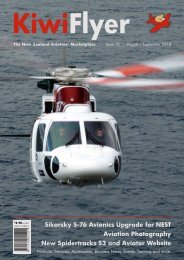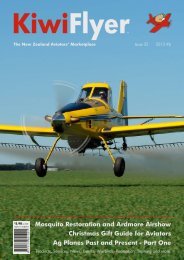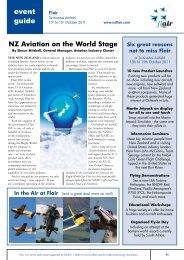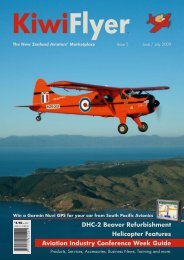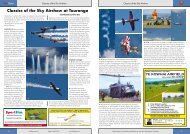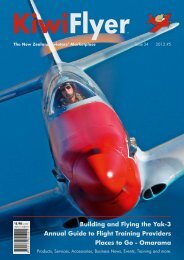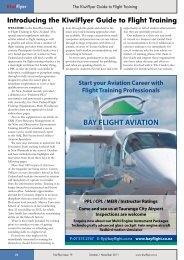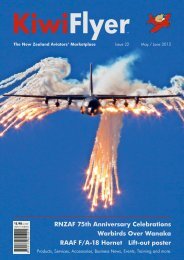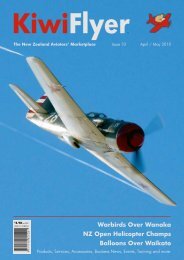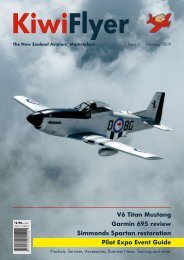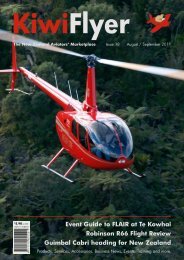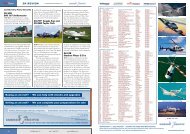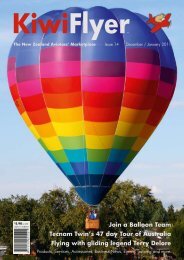Trans Tasman Furio Subsidised Aircraft Tracking Aero ... - KiwiFlyer
Trans Tasman Furio Subsidised Aircraft Tracking Aero ... - KiwiFlyer
Trans Tasman Furio Subsidised Aircraft Tracking Aero ... - KiwiFlyer
Create successful ePaper yourself
Turn your PDF publications into a flip-book with our unique Google optimized e-Paper software.
<strong>KiwiFlyer</strong> History Feature<br />
The Harvard turns 70: A Birthday Story<br />
An anniversary of note for any aviation enthusiast<br />
recently occurred. Frank Parker, who pilots most<br />
things that fly but particularly the lead Harvard<br />
of the Roaring 40’s Display Team, provided the<br />
following testament to a much loved aircraft.<br />
THE RATIONALE of why a ‘ship’ is a<br />
‘she’ is long lost in antiquity, however this<br />
tradition has transcended from the oceans<br />
to the sky where aircraft are generally<br />
referred to in the feminine gender. It is<br />
reasonable then to refer to our subject<br />
which recently celebrated 70 years since its<br />
inception, as a Gentle Grandmother.<br />
The Harvard Evolution<br />
North American Aviation was founded<br />
in December 1928 as an ‘aviation holding<br />
company’. Due to political changes in<br />
aviation law the company was reformed<br />
as a manufacturing concern about 1934.<br />
The new President, James “Dutch”<br />
Kindelberger, moved the Company to<br />
California and concentrated on Training<br />
<strong>Aircraft</strong>, believing they could not compete<br />
with the larger, established manufacturers<br />
for the more exotic Fighter and Bomber<br />
aircraft requirements.<br />
The NA-16, a low wing monoplane<br />
design won the 1934 Army Air Corps<br />
(AAC) Trainer Competition. This modest<br />
The NA-16 Trainer.<br />
The BT-9 Trainer.<br />
open cockpit aircraft with a 400 hp Wright<br />
engine began the genesis of an aircraft that<br />
would remain in military service for the<br />
next 47 years.<br />
The NA-16 was first modified to<br />
Military requirements to have enclosed<br />
cockpits (it was cold on the Prairie) and<br />
became the BT-9 (BT standing for Basic<br />
Trainer), which was operated by the AAC.<br />
The BT-9 design was further modified<br />
to include retractable undercarriage and a<br />
larger engine (Pratt<br />
and Whitney R1340<br />
Wasp) to become the<br />
AT-6 (AT standing<br />
for Advanced<br />
Trainer).<br />
In this guise, in<br />
1938, the aircraft was<br />
purchased by the UK<br />
to meet RAF training<br />
requirements.<br />
Following RAF<br />
tradition, as a training aircraft it was named<br />
after a university (compare with Airspeed<br />
Oxford), in this case to reflect its country<br />
of origin, and so began the Harvard Story.<br />
Subsequently the design was adopted<br />
by the major Western Powers to fulfill<br />
pilot training requirements as an advanced<br />
trainer, including pure flying and<br />
operational roles of bombing and gunnery.<br />
In the USA the aircraft was the ‘T-6’ in<br />
the AAC, the ‘SNJ’ in the US Navy (this<br />
designation comes from S = Scout [i.e.<br />
small/light aircraft], N = designation for<br />
heavier than air aircraft [the Navy operated<br />
airships at this time], and J = manufactures<br />
designation for North American [N had<br />
already been allotted to Northrop]). In the<br />
1940’s North American opened a factory<br />
in Dallas Texas where much of the T-6<br />
production became based. This led to<br />
the ‘Texan’ name by which the aircraft is<br />
commonly referred to in the United States.<br />
In Commonwealth Service (UK,<br />
Canada, South Africa, NZ), in line with<br />
the RAF, the aircraft was referred to as<br />
the Harvard. Meanwhile Australia had<br />
developed an indigenous design, based on<br />
the NA-16, known as the Wirraway. This<br />
aircraft is ‘very similar’ in appearance to the<br />
Harvard, but very different under the skin.<br />
The first Harvard (North American designation NA-49) purchased by the RAF.<br />
Military Pilot Training<br />
During the War Years an estimated<br />
17000 Harvard, T-6, and SNJ variants were<br />
built and most Allied Pilots came to terms<br />
with it at some stage of their flight training.<br />
Hence the aircraft’s reputation as ‘The Pilot<br />
Maker’.<br />
Many Air Forces continued using the<br />
Harvard for training after the war years.<br />
10 <strong>KiwiFlyer</strong> Issue 4 April / May 2009 www.kiwiflyer.co.nz<br />
The RNZAF took delivery<br />
of 202 Harvard’s during the<br />
war. In 1977 when they were<br />
retired from Air Force service<br />
there were 19 left flying and<br />
many more in storage. (As an<br />
ATC Cadet in the 1960’s I can<br />
recall amazement at the stacks<br />
of wings and fuselages in the<br />
hangars at Woodbourne).<br />
The South African Air Force<br />
was the last Military Service to<br />
retire the aircraft after 55 years<br />
service in 1995.<br />
The Warbirds Movement<br />
As the Harvard was<br />
‘demobbed’ from military service<br />
it became an entry level aircraft<br />
to the ‘Warbirds’ movement.<br />
Indeed in 1977 an ex RNZAF<br />
aircraft in flying condition could<br />
be purchased for around $6000,<br />
the cost of an average family car.<br />
Harvard 1092 (ZK–WAR) was<br />
purchased by a group of enthusiasts to<br />
become the foundation aircraft of the NZ<br />
Warbirds Association. Currently there are<br />
six aircraft based with NZWA at Ardmore<br />
and at least another six flyable examples<br />
scattered throughout the rest of New<br />
Zealand.<br />
Outside of the enthusiasts involved in<br />
maintaining and operating these aircraft,<br />
they are probably best recognised by the<br />
public through their appearance in the<br />
Airshow Circuit by the NZWA Roaring<br />
40’s Team. The concept of this formation<br />
aerobatic team was created in the 1970’s by<br />
Trevor Bland and Ernie Thompson flying<br />
ZK-WAR and ZK-ENE “doing aerobatics<br />
and low level beat-ups”. By the mid 1980’s<br />
the Roaring 40’s became an established NZ<br />
Warbirds Team with four or more aircraft<br />
and a polished routine. The Roaring 40’s<br />
History Feature<br />
RNZAF Harvards, circa 1970.<br />
The Roaring 40’s Display Team<br />
name, from the winds of the 40’s latitudes<br />
was chosen as it reflects the roar of the<br />
aircraft, their time of manufacture, their<br />
age at that time, and the age of the pilots,<br />
though the later is debatable!<br />
In the USA, a robust aircraft owners<br />
group, the ‘North American Trainer<br />
Association’, NATA, which includes T-6 /<br />
Harvard, T-28, P-51 and B-25 aircraft (all<br />
North American Aviation WW II aircraft)<br />
is proactive in promoting the continued<br />
T-6 Texans at the Dubque Iowa Fly-in.<br />
operation of these aircraft for<br />
future generations to enjoy.<br />
NATA is currently working with<br />
the USA FAA reviewing the<br />
operation of ‘aged aircraft’ with<br />
emphasis on metal fatigue and<br />
maintenance procedures. This<br />
work and the continued support<br />
of enthusiastic owners will<br />
ensure the Harvard Growl will<br />
echo the skies for many more<br />
years ahead.<br />
In the USA it is normal to<br />
attract 30 to 40 aircraft to NATA<br />
sponsored ‘fly-ins’ and more to<br />
events like Sun ‘n’ Fun (Florida)<br />
or EAA at Oshkosh.<br />
Meet a Gentle Grandmother<br />
And so, the next time you<br />
see one of these aircraft and<br />
hear that ‘beautiful noise’ (as the<br />
propeller tips break the sound<br />
barrier), take time to reflect on<br />
70 years of aviation history. This 1930’s<br />
girl is letting you know she’s in town, so<br />
make the opportunity to talk to the guys<br />
and girls who have the time and energy<br />
(plus a few dollars) to keep this piece<br />
of history where it belongs - in the air,<br />
rather than languishing in a static museum<br />
environment. Take a photo with the kids.<br />
We are passionate about our “Harvards”<br />
and would be delighted to share that<br />
passion with you.<br />
<strong>KiwiFlyer</strong> welcomes contributions from readers that are of general interest to the NZ aviation community. Call us to discuss. 11


